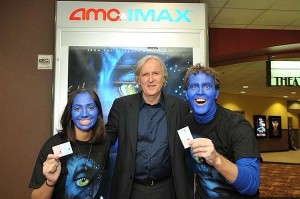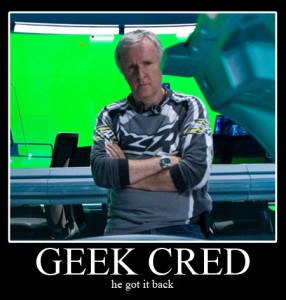 There was an interview with James Cameron in August in Entertainment Weekly that just came to my attention. I found three items in the piece of interest.
There was an interview with James Cameron in August in Entertainment Weekly that just came to my attention. I found three items in the piece of interest.
First, an interesting question is asked about what may be referred to as the “cinematic canon.” The interviewer, Benjamin Svetkey, asked about the new version of Avatar with nine minutes of additional footage, and then contrasts this with the expanded and revised version of Star Wars. He wonders whether this “blurs the lines of history” and which version will be considered the “official director’s cut.” In Cameron’s response he doesn’t argue for any one official version, but instead states that differing forms of the film will be available for consumers based upon their tastes. It used to be that once a film was completed and distributed that this was the end of the story. With the growing appetite of cinema fans, the ability of directors to take advantage of DVDs with expanded footage and behind the scenes extras, and movie studios which desire to make as much revenue as possible from films through their initial release as well as the home DVD market, we will likely see the blurring of this line continuing as a trend, particularly with films of the fantastic that do well at the box office. Perhaps Cameron will now duel with Lucas as to who can release the most versions of a film narrative over time. Lucas has the advantage of an older franchise with multiple installments (of various quality to be sure), but since Cameron is talking about a sequel to Avatar perhaps he can give Lucas a run for his money. At any rate, it appears that fans and film scholars will no longer be able to refer to a single version of a film, but will have to identify particular versions of a piece within a broader canon of the narrative.
Second, Cameron was asked to comment on the allegation that some fans suffered depression as a result of their experience of Pandora in movie theaters against which their real-world experience of earth is felt to pale by comparison. The director downplays these media reports as hyperbole. This is surprising in that one of our greatest science fiction dream weavers fails to recognize the power of fantastic narratives, especially in film, for creating alternative realities and utopian possibilities. See my previous post which touched on this phenomenon.
 Finally, for some reason the interviewer tries to set Cameron up with an opportunity to “dis” devoted fans of Avatar, called “Avatards” in the piece. I’ve never heard this label before and am not sure if fans use it self-referentially, but it comes across as derogatory in the way in which the interviewer asks the question. Thankfully, Cameron refers to them simply as “fans,” and refuses to distance himself from them as William Shatner did from Star Trek fans in 1986 on Saturday Night Live in a parody on Star Trek conventions and Trekker devotion, even though the interviewer invoked this incident and gave Cameron the opportunity to follow suit. Cameron recognizes who he is, who his deepest fans are, and how is bread is buttered:
Finally, for some reason the interviewer tries to set Cameron up with an opportunity to “dis” devoted fans of Avatar, called “Avatards” in the piece. I’ve never heard this label before and am not sure if fans use it self-referentially, but it comes across as derogatory in the way in which the interviewer asks the question. Thankfully, Cameron refers to them simply as “fans,” and refuses to distance himself from them as William Shatner did from Star Trek fans in 1986 on Saturday Night Live in a parody on Star Trek conventions and Trekker devotion, even though the interviewer invoked this incident and gave Cameron the opportunity to follow suit. Cameron recognizes who he is, who his deepest fans are, and how is bread is buttered:
That was really funny [on SNL], but no. I think you have to be respectful of fans, because, let’s face it, I’m a geek. If I’m geek enough to put all the detail in the machines and technology and ecosystems in my movies, then the people who value that are going to be just as geeky as me. I can’t dis them.
Readers will also enjoy other aspects of the interview, such as Cameron’s thoughts on the future of 3D.
Related posts:
“Avatar’s Pandora Depresses Some Viewers: Utopia, Escape, and the Realized Ideal”
“And the Geeks Shall Inherit the Earth, or At Least Lead Pop Culture”





There are no responses yet